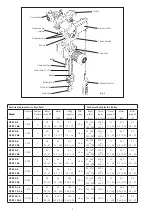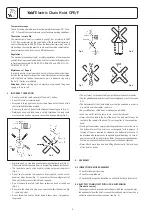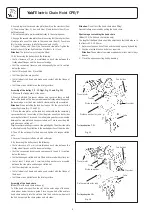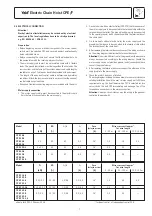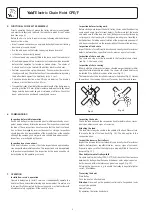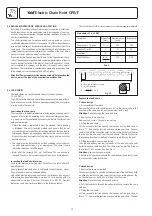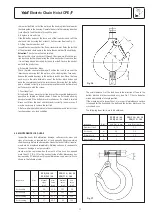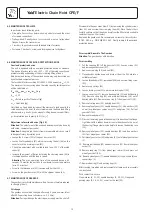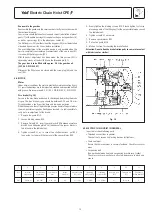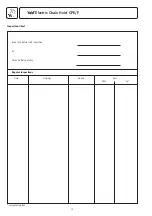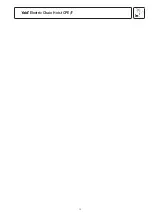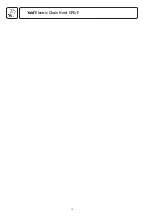
Electric Chain Hoist CPE/F
8
7. OPERATION
Installation, service, operation
Operators delegated to install, service or independently operate the
hoist must have had suitable training and be competent. Operators are
to be specifi cally nominated by the company and must be familiar with
all relevant safety regulations of the country of use.
5. FUNCTIONAL CHECK AFTER ASSEMBLY
Prior to operating the hoist, grease the trolley pinions (manual geared
and electric trolleys) and lubricate the load chain when it is not under
load (see page 9).
Before the hoist is put into regular service, following additional inspec-
tions must be made:
• Are all screwed connections on hoist and trolley tight and are all locking
devices in place and secure?
• Are the end stops on the trolley runway in place and secure?
• Is the chain drive correctly reeved?
• Is the chain end stop correctly fitted to the loose end of the load chain?
• All units equipped with two or more chain strands should be inspected
before initial operation for twisted or kinked chains. The chains of
2-strand hoists may be twisted if the bottom block is rolled over.
• Perform an operation cycle without load. The chain should move in a
steady, smooth way. Check the function of the overload device by raising
the bottom block against the hoist body (max. 5 sec.).
• Check the brake function when lifting and lowering. The braking
distance must not be more than 50 mm.
• Traverse the trolley (if available) the complete length of the trolley runway
ensuring that the 2 - 4 mm lateral clearance between the trolley wheel
flange and the beam outer edge is maintained at all times. Check that
beam end stops are positioned correctly and secure.
6. COMMISSIONING
Inspection before initial operation
Each hoist/trolley must be inspected prior to initial operation by a com-
petent person and any failures be removed. The inspection is visual and
functional. These inspections have to assure that the hoist is safe and
has not been damaged by incorrect transport or storage. Inspections
should be made by a representative of the manufacturer or the supplier
although the company can assign its own suitably trained personnel.
Inspections are instigated by the user.
Inspection by a crane expert
If the hoist is used as a crane, it has to be inspected and approved by a
crane expert before initial operation. This inspection has to be registered
in the crane inspection book. The inspection by the crane expert has to
be instigated by the operating company.
Inspection before starting work
Before starting work inspect the hoist/trolley, chains and all load bearing
components every time for visual defects. Furthermore test the brake
and make sure that the load and hoist/trolley are correctly attached by
carrying out a short work cycle of lifting and lowering resp. travelling in
both directions. Selection and calculation of the proper suspension point
and beam construction are the responsibility of the operating company.
Inspection of load chain
Inspect the chain for suffi cient lubrication and visually check for external
defects, deformations, superfi cial cracks, wear or signs of corrosion.
Inspection of chain end stop
The chain end stop must be connected to the free (idle) chain strand
(see Fig. 1 - chain end stop).
Inspection of chain reeving
All units with two or more chain strands should be inspected prior to initial
operation for twisted or kinked chains. The chains of 2-strand hoists may
be twisted if the bottom block was rolled over (Fig. 13).
The load chain has to be installed according to illustration (Fig. 9). Hereby
the welds on the standing links must face away from the load sheave.
Inspecting the hooks
Check the load hook and the suspension hook for deformations, cracks,
damages, abrasion and signs of corrosion.
Attaching the load
The load must always be seated in the saddle of the hook. Never attach
the load to the tip of the load hook (Fig. 14). This also applies to the
suspension hook.
Inspect the traverse (for trolleys)
Inspect the traverse for correct assembly and visually check for external
defects, deformations, superfi cial cracks, wear or signs of corrosion.
Especially make sure that the roll pins are properly fi tted to the centre
traverse (Fig. 10).
Check adjustment of trolley width
On chain hoists with trolley (CPV/F-VTP/G(E) check that the clearance
between the trolley wheel fl ange and the beam outer edge is equal on
both sides and within the tolerances given (see page 5, Fig. 10).
Enlarging the clearances, e. g. to enable the trolley to negotiate tighter
curves, is forbidden.
Traversing the hoist
Plain trolley:
Push the hoist or attached load.
Attention:
Never pull on the pendant control cable. Suspended loads
may only be pushed.
Geared trolley:
By operating the trolley hand chain.
Fig. 13
Fig. 14
Содержание CPEF
Страница 15: ...Electric Chain Hoist CPE F 15...
Страница 16: ...Electric Chain Hoist CPE F 16...
Страница 17: ...Electric Chain Hoist CPE F 17...


